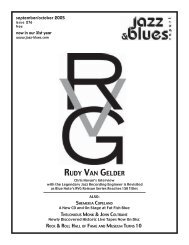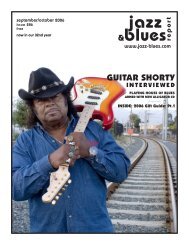#November 288-WEB2 - the Jazz & Blues Report
#November 288-WEB2 - the Jazz & Blues Report
#November 288-WEB2 - the Jazz & Blues Report
You also want an ePaper? Increase the reach of your titles
YUMPU automatically turns print PDFs into web optimized ePapers that Google loves.
working against him and more people get killed around him<br />
including <strong>the</strong> person at <strong>the</strong> Picuyane’s morgue who had been<br />
helping St. Cyr in trying to unravel <strong>the</strong> series of murders.<br />
Unlike <strong>the</strong> earlier novels, Jelly Roll Morton is now in Chicago<br />
and jazz has a lower profile than in <strong>the</strong> earlier novels. Yet, <strong>the</strong><br />
Sicilian grocery and saloon owner, whose place St. Cyr has a<br />
room at, features a jazz band in <strong>the</strong> saloon and Beansoup,<br />
<strong>the</strong> street kid who had been assisting St. Cyr and had been in<br />
<strong>the</strong> waif’s home at <strong>the</strong> same time as Louis Armstrong, is now<br />
playing harmonica in Jackson Square behind Charlie Jackson,<br />
a blues singer and guitarist who performs’Duncan and<br />
Brady, a ballad about an altercation between a saloon keeper<br />
and a sheriff in East St. Louis.<br />
Fulmer continues to develop his characters and weaves<br />
<strong>the</strong> story toge<strong>the</strong>r in a compelling fashion.<br />
I could not put this down after starting it or <strong>the</strong> two earlier<br />
novels. He really brings this long gone period to life in all<br />
three of <strong>the</strong>se excellent books. If you like mysteries, you certainly<br />
might read Chasing <strong>the</strong> Devil’s Tail first (it and Jass<br />
are currently available in paperback) and if you enjoy it (as I<br />
suspect you will), you will dig into <strong>the</strong> sequels including Rampart<br />
Street. I am not sure if this is <strong>the</strong> last Valentin St. Cyr<br />
novel, as Fulmer’s next novel, The Dying Crapshooter’s <strong>Blues</strong><br />
(scheduled for publication in January) is set in Atlanta, Georgia<br />
and amazon.com suggests that Fulmer will be bringing<br />
“ano<strong>the</strong>r absorbing mystery in a new setting raucous with<br />
music and rich history.” The Valentin St. Cyr mysteries certainly<br />
are absorbing. Ron Weinstock<br />
TEXAS ZYDECO<br />
By Roger Wood & James Fraher (photographer)<br />
UNIVERSITY OF TEXAS 2006<br />
Zydeco music is usually associated with Louisiana, but,<br />
historically Texas, and especially <strong>the</strong> city of Houston, has<br />
been central to <strong>the</strong> growth and development of <strong>the</strong> idiom<br />
from <strong>the</strong> more traditional la la music of <strong>the</strong> Creole population<br />
that is concentrated in southwestern Louisiana and neighboring<br />
portions that include Texas. The place of Texas in <strong>the</strong><br />
rise and evolution of zydeco is <strong>the</strong> subject of”Texas Zydeco,<br />
<strong>the</strong> latest collaboration between writer Roger Woof and photographer<br />
James Fraher, who previously collaborated in Down<br />
in Houston <strong>Blues</strong> in Bayou City, <strong>the</strong> superb book on Houston’s<br />
blues scene.<br />
Like <strong>the</strong> previous volume, Wood does more than simply<br />
provide sketches of <strong>the</strong> history of <strong>the</strong> music. He takes us into<br />
<strong>the</strong> world of <strong>the</strong> zydeco as his first chapter introduces us to<br />
<strong>the</strong> various venues for zydeco and <strong>the</strong> audience and musicians<br />
<strong>the</strong>re ranging from <strong>the</strong> clubs and church dances to <strong>the</strong><br />
all day festivals at a rodeo arena. The history of <strong>the</strong> music as<br />
it was transformed from la la to zydeco and some of <strong>the</strong> pioneering<br />
figures and recordings are presented, and <strong>the</strong> fact<br />
that some of <strong>the</strong> recordings were made in Houston, including<br />
a rare Lightnin’ Hopkins recording on organ,’Zologo. Folklorist<br />
Mack McCormick was responsible for <strong>the</strong> spelling of<br />
zydeco, but it was not until a Clifton Chenier recording used<br />
that spelling that this spelling received <strong>the</strong> credibility until it<br />
became <strong>the</strong> established way to spell <strong>the</strong> term.<br />
A chapter is devoted to Chenier and his influence.<br />
Chenier’s mix of traditional Creole music with rhythm and<br />
blues, as well as his use of <strong>the</strong> piano accordion, led to <strong>the</strong><br />
emergence of zydeco as a musical genre. Through interviews<br />
November/December 2006 • Issue <strong>288</strong><br />
with some of Clifton’s contemporaries, as well as some of<br />
<strong>the</strong> musicians who played with him including his son C.J.<br />
and guitarists Philip Walker and Sherman Washing, <strong>the</strong>y recall<br />
<strong>the</strong>ir experiences with Clifton and how he was a mentor<br />
to <strong>the</strong>m, and <strong>the</strong>y recognize even today <strong>the</strong> value of his lessons<br />
for <strong>the</strong>m. Clifton was a remarkable person. Chenier invented<br />
<strong>the</strong> frottoir (rubboard) which replaced <strong>the</strong> washboards<br />
that had been used previously, having <strong>the</strong> first frottoirs fabricated<br />
and Wood spends some pages with <strong>the</strong> individuals that<br />
crafted <strong>the</strong>se instruments for use.<br />
Ano<strong>the</strong>r chapter discusses some of <strong>the</strong> post-Chenier<br />
performers in <strong>the</strong> world of Texas zydeco, noting that many,<br />
but not all, have adopted <strong>the</strong> button accordion as opposed to<br />
<strong>the</strong> chromatic piano accordion, and provides an overview of<br />
<strong>the</strong>se new breed performers including Corey Ledet, Dora and<br />
<strong>the</strong> Zydeco Bad Boyz, J. Paul and Skip Riteau, and in showing<br />
<strong>the</strong>ir individual maturation as artists how Texas remains<br />
a fertile ground for zydeco to continue to evolve.<br />
James Fraher, certainly one of <strong>the</strong> most outstanding blues<br />
photographers alive, contributes some stunning photography.<br />
It is unfortunate that Wood and Fraher did not include<br />
some actual photographs of Chenier and o<strong>the</strong>r masters that<br />
Fraher never was able to document, as a photograph of a old<br />
Zodico poster for Chenier is not quite <strong>the</strong> same thing. But<br />
this is only a quibble as this book brings out <strong>the</strong> world of<br />
zydeco, not simply reciting <strong>the</strong> lives of major figures, and<br />
joins Down in Houston as an important and engrossing book<br />
on African-American vernacular music traditions.<br />
Ron Weinstock<br />
THE END<br />
...of part 3 of <strong>the</strong> 2006 Holiday Gift Guide. Check out<br />
our next special issue in December for Part 4, and<br />
look for <strong>the</strong> stand-alone gift guide with all <strong>the</strong> entries<br />
for 2006 plus <strong>the</strong> 2005 entries as well. The standalone<br />
guide will be coming to our website only...<br />
sometime in mid-November.<br />
MORE CD REVIEWS<br />
VON FREEMAN<br />
Good Love<br />
PREMONITION RECORDS<br />
One of <strong>the</strong> unsung masters of <strong>the</strong> tenor saxophone, Von<br />
Freeman shows little sign of slowing down after all <strong>the</strong>se years.<br />
A contemporary of Sonny Rollins, Gene Ammons and Sonny<br />
Stitt, Freeman would have become a household name if he<br />
had left Chicago decades ago. Instead he eschewed fame to<br />
stay home mentoring musicians and playing primarily for<br />
his hometown fans. Freeman has been a most versatile musician<br />
who could play free jazz with <strong>the</strong> same authority as he<br />
could romp through hard bop or get down into <strong>the</strong> nitty gritty<br />
on a blues (The legendary bluesman Sunnyland Slim was<br />
one of his earliest employers). His latest CD on Premonition,<br />
Good Love, showcases Freeman on a set of ballads and<br />
blues as he performs songs that in <strong>the</strong>ir time were his every<br />
day repertoire. He is accompanied by a wonderfully sympa<strong>the</strong>tic<br />
trio of Richard Wyands on piano, John Webber on bass<br />
and Jimmy Cobb on drums. From <strong>the</strong> opening moments of<br />
PAGE TWENTY







